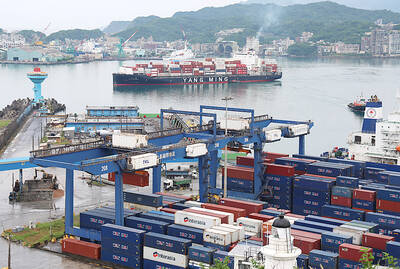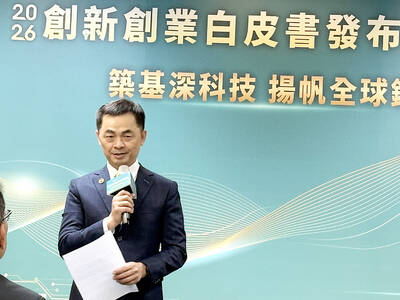Advantech Co (研華) yesterday previewed its vision for an Industrial Internet of Things (IIoT) market, which it said would gradually take shape in the next five to 10 years and add value to the company’s hardware offerings
The world’s largest industrial computer supplier aims to sow the seeds for the IIoT market through a “cocreation” model, making early bets on developers of intelligent solutions that would be powered by its cloud computing platform, Advantech chairman K.C. Liu (劉克振) said.
IIoT applications would become widely implemented across a multitude of industries and Advantech is working closely with industry professionals to integrate their knowledge with the coming technology shift and create solution-ready packages (SRPs), Liu said at a news conference at the company’s IoT Campus in New Taipei City’s Linkou District (林口).
Eventually, the SRPs would become an important aspect of the IIoT supply chain, along with sensors, edge computing, communications, and platform as a service (PaaS) and other cloud-based services.
Edge computing is a method of optimizing cloud computing by having some computation performed at the device level, whereas PaaS involves providing companies with the cloud infrastructure necessary to build and maintain applications.
However, the IIoT space is fragmented, and the company is working hard to create standardized and easily duplicated SRPs based on a combination of software and hardware products that could be rolled out by system integrators, Liu said.
Advantech showcased nine SRP partners that are developing intelligent solutions for managing hospital wards, vehicle fleets, factory equipment and other facilities.
The company in March approved plans to acquire a 19 percent stake in Nippon RAD Inc to help it become a leading system integrator in the vast Japanese market, Liu added.
Advantech has been offering its WISE PaaS service, a new cloud-enabled platform, at a very accessible price for its development partners during the growth stage, he said.
The company has also scaled down its venture capital activities to focus on investing in its development partners and acquiring stakes of 20 to 30 percent in like-minded IIoT start-ups and partners, Liu said.
“We expect US$500 million in overall incremental revenue gains by 2023,” Liu said, adding that the smart factory, or Industry 4.0, and smart city solutions segments would see the fastest IIoT deployment.
Liu envisions that the IIoT market would be divided into two segments: Half of the potential revenues would be controlled by hardware and software platform providers such as Advantech, while the other half would represented by SRP providers, he said.
The scheme would add value to Advantech’s hardware offerings, similar to how iPhones garnered popularity through Apple’s software and services, he said.
“We supply the beef to supply the steakhouses that would be opened up by our SRP partners,” Liu added.
Meanwhile, the company said it would be ready to unveil 30 SRPs at its IoT Co-Creation Summit which is scheduled for November in Suzhou, China.

CHIP RACE: Three years of overbroad export controls drove foreign competitors to pursue their own AI chips, and ‘cost US taxpayers billions of dollars,’ Nvidia said China has figured out the US strategy for allowing it to buy Nvidia Corp’s H200s and is rejecting the artificial intelligence (AI) chip in favor of domestically developed semiconductors, White House AI adviser David Sacks said, citing news reports. US President Donald Trump on Monday said that he would allow shipments of Nvidia’s H200 chips to China, part of an administration effort backed by Sacks to challenge Chinese tech champions such as Huawei Technologies Co (華為) by bringing US competition to their home market. On Friday, Sacks signaled that he was uncertain about whether that approach would work. “They’re rejecting our chips,” Sacks

Taiwan’s exports soared 56 percent year-on-year to an all-time high of US$64.05 billion last month, propelled by surging global demand for artificial intelligence (AI), high-performance computing and cloud service infrastructure, the Ministry of Finance said yesterday. Department of Statistics Director-General Beatrice Tsai (蔡美娜) called the figure an unexpected upside surprise, citing a wave of technology orders from overseas customers alongside the usual year-end shopping season for technology products. Growth is likely to remain strong this month, she said, projecting a 40 percent to 45 percent expansion on an annual basis. The outperformance could prompt the Directorate-General of Budget, Accounting and

NATIONAL SECURITY: Intel’s testing of ACM tools despite US government control ‘highlights egregious gaps in US technology protection policies,’ a former official said Chipmaker Intel Corp has tested chipmaking tools this year from a toolmaker with deep roots in China and two overseas units that were targeted by US sanctions, according to two sources with direct knowledge of the matter. Intel, which fended off calls for its CEO’s resignation from US President Donald Trump in August over his alleged ties to China, got the tools from ACM Research Inc, a Fremont, California-based producer of chipmaking equipment. Two of ACM’s units, based in Shanghai and South Korea, were among a number of firms barred last year from receiving US technology over claims they have

BARRIERS: Gudeng’s chairman said it was unlikely that the US could replicate Taiwan’s science parks in Arizona, given its strict immigration policies and cultural differences Gudeng Precision Industrial Co (家登), which supplies wafer pods to the world’s major semiconductor firms, yesterday said it is in no rush to set up production in the US due to high costs. The company supplies its customers through a warehouse in Arizona jointly operated by TSS Holdings Ltd (德鑫控股), a joint holding of Gudeng and 17 Taiwanese firms in the semiconductor supply chain, including specialty plastic compounds producer Nytex Composites Co (耐特) and automated material handling system supplier Symtek Automation Asia Co (迅得). While the company has long been exploring the feasibility of setting up production in the US to address